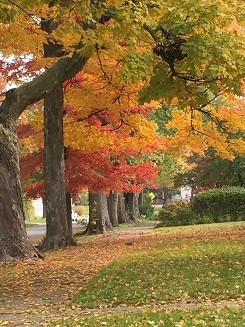 Late Fall Newsletter – Print (PDF)
Late Fall Newsletter – Print (PDF)
Dear Customers,
This year we all experienced drought conditions in August all the way through October. Excessively dry air, no rain, high temperatures, all of which combined to cause continuing damage from the summer all the into the fall. The only real benefit to weather conditions like these, is that we could control the amount of water lawns received by watering, either by hand or with sprinkler systems. Areas we seeded, if watered, recovered beautifully and will continue to grow in as the temperatures drop and we get more rain.
A lot of the damage we saw was specifically caused by mature trees pulling their much needed residual moisture out of the soil. A dry, stressed lawn simply can’t compete with a thirsty Oak tree! Even with drawing in as much moisture from the surrounding area as possible, the drought conditions caused the trees to start dropping their leaves very early. Now that we are moving into the Late Fall, please try to remove the heavy leaves that fall on your lawn as quickly as possible. Leaves that are left on the turf block the sunlight so the grass cannot produce chlorophyll. Since Winter doesn’t begin until December 21st, there is still time for your lawn and landscape to recover this season.
Leaf Removal
The easiest and safest way of removing leaves from your lawn is to remove them with a lawn mower bag while cutting. For heavier amounts of leaves, raking is not a problem on established turf. Please note on newly-seeded, shady or shallow-rooted areas, heavy raking may be damaging to the lawn. A suggestion might be to either rake these areas lightly or (if you have one) to use a leaf blower that would remove the leaves off the weak areas onto established turf, driveway, street or sidewalk where they can be raked into bags. It is important that you continue to remove the leaves from your lawn as long as they continue to fall, especially where they can create a problem. This means raking and clearing right into December and January. Leaves left on the lawn cause dead areas and other problems.
If you need any assistance in leaf removal, please contact us early and we will make arrangements for a cleanup.
Watering Requirements
After your lawn service is completed, give your lawn a good soaking to water the products into the soil. If it is too cold to water your lawn after your service, it is advisable to delay cutting your lawn or raking the leaves for a few days to allow the products to work into the soil. In the Autumn, the lawns become drier than most people realize due to windy days, trees absorbing moisture before winter dormancy and cooler temperatures. Therefore, your lawn should be watered as needed. If there is no measurable rainfall for a week, make sure that you provide a good soaking, especially if extensive seeding was done in the Fall service. Continue watering until the weather prohibits.
For those customers who have a sprinkler system, you will need to water three times a week because of the amount of time needed to be sure each zone is properly watered – especially if extensive seeding was done in the Fall. Due to the cooler temperatures this time of year, you need to set your sprinkler to start later in the morning, for example at 10 a.m. rather than 5 a.m. You may also reduce the amount of time each zone is on. Please do not set the system to come on the day your lawn is scheduled to be mowed. Unless directed otherwise by our company, you can schedule your sprinkler system’s winterization after November 15th.
Your Landscape
Evaluate your shrubs and trees at this time to see how they survived this years drought conditions. If you need to replace dead or dying plants, the Fall is the best time. For Deciduous trees that lose their leaves and go dormant, Winter is the best time to have the dead wood cut out and to have the trees thinned to prevent future damage. Since it is easier to trim trees when there are no leaves on them and in order to keep their crews busy, arborists usually will give you a discount if you do this work during the Late Fall and Winter.
We will be starting our Late Fall Service shortly. If you have any questions, please feel free to contact us on 302-792-2201 or at Finolawn@gmail.com.
Please note that the company’s new mailing address is:
Finocchiaro Lawn & Landscape, Inc.
P. O. Box 9524
Wilmington DE 19809
For those who pay for our service through their bank’s online pay site, please be sure to go in and correct our name and mailing address to this new one.
Finally, we presently have a few openings in our schedule for new customers. If you know anyone who may be interested in our service, we would appreciate your recommending us.
Have a wonderful Late Fall!
Gabriel L. Clouser, President
Eric M. Plummer, Vice President
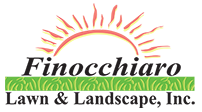

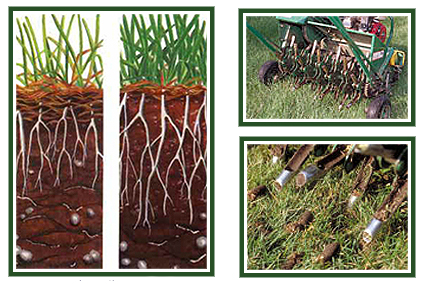 Core Aeration offers the following benefits to the lawn.
Core Aeration offers the following benefits to the lawn.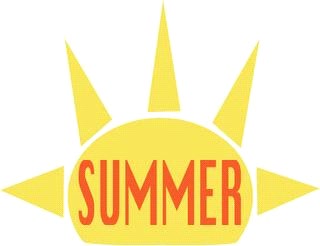
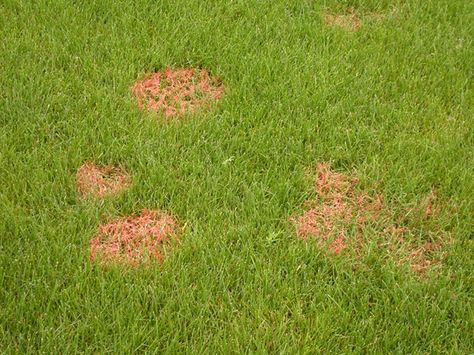 During the summer months, Turf Disease becomes active due to the high temperatures and high humidity. In June we saw 8″ of rainfall, well above normal, and with most of the storms taking place in the evening hours. This created the perfect environment for turf diseases to spread. All turf disease is soil-born, spreading from fungal spores in the soil up, the grass leaf, to infect the plant. Two of the most common diseases we see are Red Thread and Dollar Spot.
During the summer months, Turf Disease becomes active due to the high temperatures and high humidity. In June we saw 8″ of rainfall, well above normal, and with most of the storms taking place in the evening hours. This created the perfect environment for turf diseases to spread. All turf disease is soil-born, spreading from fungal spores in the soil up, the grass leaf, to infect the plant. Two of the most common diseases we see are Red Thread and Dollar Spot.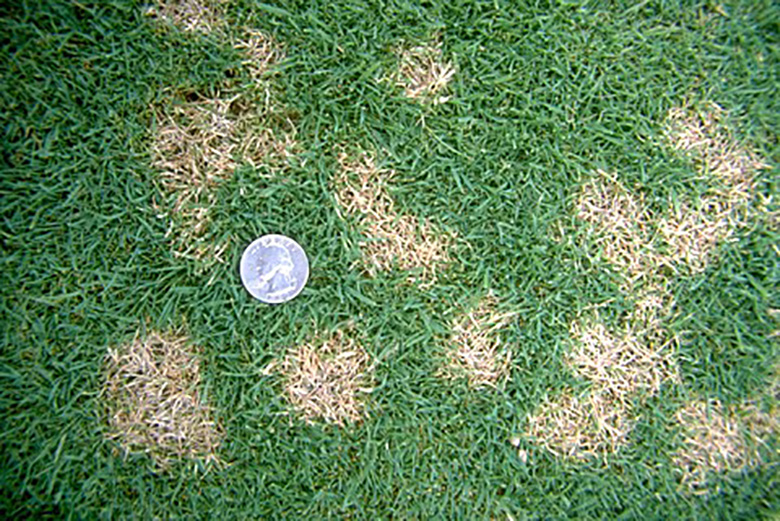 Dollar Spot appears as small circular straw colored spots in the lawn. With closer examination, you can see the brown lesion blight on the grass leaf. This disease damages the grass leaf but does not affect the roots or the crown of the plant. Dollar Spot thrives under high temperatures and humidity when the lawn does not have a chance to dry out. Another common cause is mowing the lawn too short. Short turf is more easily infected than turf cut at the correct height. Our company spot treats the areas around the disease with a curative fungicide to reduce the
Dollar Spot appears as small circular straw colored spots in the lawn. With closer examination, you can see the brown lesion blight on the grass leaf. This disease damages the grass leaf but does not affect the roots or the crown of the plant. Dollar Spot thrives under high temperatures and humidity when the lawn does not have a chance to dry out. Another common cause is mowing the lawn too short. Short turf is more easily infected than turf cut at the correct height. Our company spot treats the areas around the disease with a curative fungicide to reduce the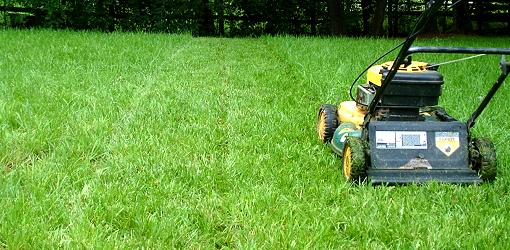 Proper mowing is one of the “Best Cultural Practices” for the lawn. By mowing at 4″, the turf is better able to resist Turf Disease and other summer stresses. Only mow the lawn when it is needed during the summer, which may be once every 10 to 14 days depending on how fast the turf is growing. Please follow our mowing instructions on the Summer Bulletin which the men leave at your home at the time of your service and is posted on our website.
Proper mowing is one of the “Best Cultural Practices” for the lawn. By mowing at 4″, the turf is better able to resist Turf Disease and other summer stresses. Only mow the lawn when it is needed during the summer, which may be once every 10 to 14 days depending on how fast the turf is growing. Please follow our mowing instructions on the Summer Bulletin which the men leave at your home at the time of your service and is posted on our website.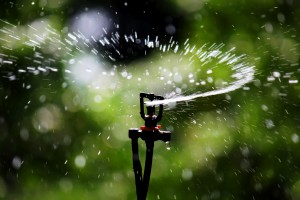 Summer Watering
Summer Watering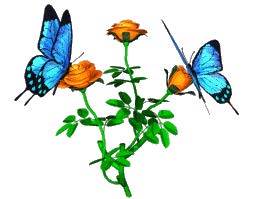
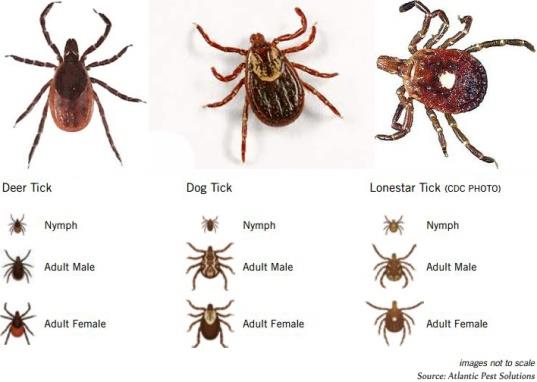 As the climate changes and our summers become longer and warmer, fleas and ticks are becoming more prevalent than ever throughout the state of Delaware. While these insects do not cause damage to the turf or landscape they can be harmful to our pets and families. Finocchiaro Lawn & Landscape, Inc. offers a program that greatly reduces and helps to control fleas and ticks, including the ones that can spread lime disease. Our Program uses a granular to control the fleas and ticks in the ground without harming the beneficial insects such as bees, butterflies and ladybugs in the landscape. If you are interested in our Flea & Tick Program please contact us for more details at finolawn@gmail.com or at 302-792-2201.
As the climate changes and our summers become longer and warmer, fleas and ticks are becoming more prevalent than ever throughout the state of Delaware. While these insects do not cause damage to the turf or landscape they can be harmful to our pets and families. Finocchiaro Lawn & Landscape, Inc. offers a program that greatly reduces and helps to control fleas and ticks, including the ones that can spread lime disease. Our Program uses a granular to control the fleas and ticks in the ground without harming the beneficial insects such as bees, butterflies and ladybugs in the landscape. If you are interested in our Flea & Tick Program please contact us for more details at finolawn@gmail.com or at 302-792-2201.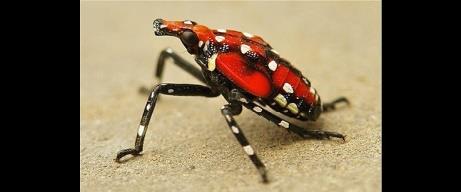 The spotted lantern fly is an invasive plant-hopper insect native to China, India and Vietnam. The insect has a large
The spotted lantern fly is an invasive plant-hopper insect native to China, India and Vietnam. The insect has a large 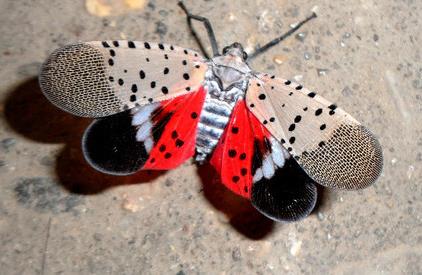 number of host plants in the landscape and in agriculture where it can cause significant damage. Pennsylvania has issued a quarantine for the insect in all of the counties where it has been found and is asking for the help of both residents and businesses to help control the spread of the insect. Please visit www.agriculture.pa.gov to learn more about the Spotted Lantern Fly and about how you can help.
number of host plants in the landscape and in agriculture where it can cause significant damage. Pennsylvania has issued a quarantine for the insect in all of the counties where it has been found and is asking for the help of both residents and businesses to help control the spread of the insect. Please visit www.agriculture.pa.gov to learn more about the Spotted Lantern Fly and about how you can help.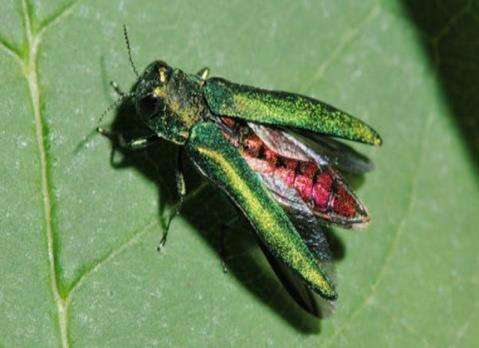 The Emerald Ash Borer is another invasive insect from Asia that is causing severe damage throughout the landscape. The beetle lays its eggs in the bark of the Ash Tree and the larva feed beneath the bark, killing the tree. The beetle has caused the death of hundreds of millions of trees across 35 states and parts of Canada. Ash Trees can be treated to help protect the tree from an infestation, however many communities have decided to remove and replace the trees to limit the upkeep cost and possible future damage. Please visit www.emeraldashborer.info for more information about the Emerald Ash Borer or contact your local arborist.
The Emerald Ash Borer is another invasive insect from Asia that is causing severe damage throughout the landscape. The beetle lays its eggs in the bark of the Ash Tree and the larva feed beneath the bark, killing the tree. The beetle has caused the death of hundreds of millions of trees across 35 states and parts of Canada. Ash Trees can be treated to help protect the tree from an infestation, however many communities have decided to remove and replace the trees to limit the upkeep cost and possible future damage. Please visit www.emeraldashborer.info for more information about the Emerald Ash Borer or contact your local arborist.